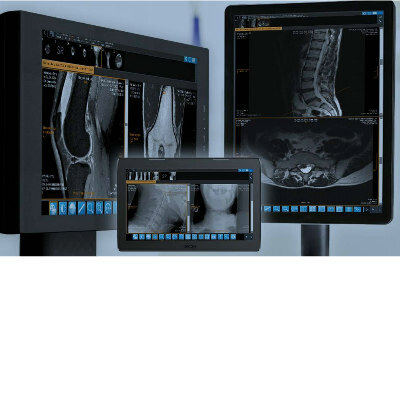Increased NIV Molecular Imaging Technologies Needed for Cancer Care
|
By MedImaging International staff writers Posted on 10 Jan 2017 |

Image: The image on the left is from before therapy, and the image on the right from three days after treatment (Photo courtesy of Penn Medicine).
According to researchers in the US, new molecular imaging technologies can facilitate the diagnosis, monitoring, and treatment of cancer, while at the same time reducing the frequency of unnecessary or ineffective therapies and minimizing side effects.
The new non-invasive molecular imaging technology can also complement biopsy data in cancer care, in cases where multiple examinations are necessary.
The researchers from the Abramson Cancer Center (PENN Medicine; Philadelphia, PA, USA), and the Perelman School of Medicine, University of Pennsylvania, (Philadelphia, PA, USA) published the review online on December 29, 2016, in the journal JAMA Oncology.
According to the authors, molecular imaging can have several significant impacts. These include helping identify patients that would benefit from targeted therapy, monitoring drug movement in the body and helping to guide drug dosing while minimizing side effects. Molecular imaging can also be used to monitor the effectiveness of drug treatments. The combined data can help predict patient outcomes and overall survival.
Lead author of the study, David A. Mankoff, MD, PhD, said, "Many of these methods are already being studied in clinical trials, but the path from clinical trials to routine clinical use is seldom easy. Molecular imaging methods face some particularly challenging hurdles such as the need to deliver the short-lived imaging probes to centers performing the imaging. We don't have a good framework yet for moving these potentially powerful diagnostic tools into routine clinical use. Among other things, we need to bring the imaging and oncology communities together to find the best way forward. In that case, molecular imaging could have directed treatment to patients highly likely to benefit and spared many other patients the toxic effects and costs of ineffective therapy."
Related Links:
Abramson Cancer Center
Perelman School of Medicine
The new non-invasive molecular imaging technology can also complement biopsy data in cancer care, in cases where multiple examinations are necessary.
The researchers from the Abramson Cancer Center (PENN Medicine; Philadelphia, PA, USA), and the Perelman School of Medicine, University of Pennsylvania, (Philadelphia, PA, USA) published the review online on December 29, 2016, in the journal JAMA Oncology.
According to the authors, molecular imaging can have several significant impacts. These include helping identify patients that would benefit from targeted therapy, monitoring drug movement in the body and helping to guide drug dosing while minimizing side effects. Molecular imaging can also be used to monitor the effectiveness of drug treatments. The combined data can help predict patient outcomes and overall survival.
Lead author of the study, David A. Mankoff, MD, PhD, said, "Many of these methods are already being studied in clinical trials, but the path from clinical trials to routine clinical use is seldom easy. Molecular imaging methods face some particularly challenging hurdles such as the need to deliver the short-lived imaging probes to centers performing the imaging. We don't have a good framework yet for moving these potentially powerful diagnostic tools into routine clinical use. Among other things, we need to bring the imaging and oncology communities together to find the best way forward. In that case, molecular imaging could have directed treatment to patients highly likely to benefit and spared many other patients the toxic effects and costs of ineffective therapy."
Related Links:
Abramson Cancer Center
Perelman School of Medicine
Latest Nuclear Medicine News
- New SPECT/CT Technique Could Change Imaging Practices and Increase Patient Access
- New Radiotheranostic System Detects and Treats Ovarian Cancer Noninvasively
- AI System Automatically and Reliably Detects Cardiac Amyloidosis Using Scintigraphy Imaging
- Early 30-Minute Dynamic FDG-PET Acquisition Could Halve Lung Scan Times
- New Method for Triggering and Imaging Seizures to Help Guide Epilepsy Surgery
- Radioguided Surgery Accurately Detects and Removes Metastatic Lymph Nodes in Prostate Cancer Patients
- New PET Tracer Detects Inflammatory Arthritis Before Symptoms Appear
- Novel PET Tracer Enhances Lesion Detection in Medullary Thyroid Cancer
- Targeted Therapy Delivers Radiation Directly To Cells in Hard-To-Treat Cancers
- New PET Tracer Noninvasively Identifies Cancer Gene Mutation for More Precise Diagnosis
- Algorithm Predicts Prostate Cancer Recurrence in Patients Treated by Radiation Therapy
- Novel PET Imaging Tracer Noninvasively Identifies Cancer Gene Mutation for More Precise Diagnosis
- Ultrafast Laser Technology to Improve Cancer Treatment
- Low-Dose Radiation Therapy Demonstrates Potential for Treatment of Heart Failure
- New PET Radiotracer Aids Early, Noninvasive Detection of Inflammatory Bowel Disease
- Combining Amino Acid PET and MRI Imaging to Help Treat Aggressive Brain Tumors
Channels
Radiography
view channel
Novel Breast Imaging System Proves As Effective As Mammography
Breast cancer remains the most frequently diagnosed cancer among women. It is projected that one in eight women will be diagnosed with breast cancer during her lifetime, and one in 42 women who turn 50... Read more
AI Assistance Improves Breast-Cancer Screening by Reducing False Positives
Radiologists typically detect one case of cancer for every 200 mammograms reviewed. However, these evaluations often result in false positives, leading to unnecessary patient recalls for additional testing,... Read moreMRI
view channel
PET/MRI Improves Diagnostic Accuracy for Prostate Cancer Patients
The Prostate Imaging Reporting and Data System (PI-RADS) is a five-point scale to assess potential prostate cancer in MR images. PI-RADS category 3 which offers an unclear suggestion of clinically significant... Read more
Next Generation MR-Guided Focused Ultrasound Ushers In Future of Incisionless Neurosurgery
Essential tremor, often called familial, idiopathic, or benign tremor, leads to uncontrollable shaking that significantly affects a person’s life. When traditional medications do not alleviate symptoms,... Read more
Two-Part MRI Scan Detects Prostate Cancer More Quickly without Compromising Diagnostic Quality
Prostate cancer ranks as the most prevalent cancer among men. Over the last decade, the introduction of MRI scans has significantly transformed the diagnosis process, marking the most substantial advancement... Read moreUltrasound
view channel
Deep Learning Advances Super-Resolution Ultrasound Imaging
Ultrasound localization microscopy (ULM) is an advanced imaging technique that offers high-resolution visualization of microvascular structures. It employs microbubbles, FDA-approved contrast agents, injected... Read more
Novel Ultrasound-Launched Targeted Nanoparticle Eliminates Biofilm and Bacterial Infection
Biofilms, formed by bacteria aggregating into dense communities for protection against harsh environmental conditions, are a significant contributor to various infectious diseases. Biofilms frequently... Read moreNuclear Medicine
view channel
New SPECT/CT Technique Could Change Imaging Practices and Increase Patient Access
The development of lead-212 (212Pb)-PSMA–based targeted alpha therapy (TAT) is garnering significant interest in treating patients with metastatic castration-resistant prostate cancer. The imaging of 212Pb,... Read moreNew Radiotheranostic System Detects and Treats Ovarian Cancer Noninvasively
Ovarian cancer is the most lethal gynecological cancer, with less than a 30% five-year survival rate for those diagnosed in late stages. Despite surgery and platinum-based chemotherapy being the standard... Read more
AI System Automatically and Reliably Detects Cardiac Amyloidosis Using Scintigraphy Imaging
Cardiac amyloidosis, a condition characterized by the buildup of abnormal protein deposits (amyloids) in the heart muscle, severely affects heart function and can lead to heart failure or death without... Read moreImaging IT
view channel
New Google Cloud Medical Imaging Suite Makes Imaging Healthcare Data More Accessible
Medical imaging is a critical tool used to diagnose patients, and there are billions of medical images scanned globally each year. Imaging data accounts for about 90% of all healthcare data1 and, until... Read more
Global AI in Medical Diagnostics Market to Be Driven by Demand for Image Recognition in Radiology
The global artificial intelligence (AI) in medical diagnostics market is expanding with early disease detection being one of its key applications and image recognition becoming a compelling consumer proposition... Read moreIndustry News
view channel
Bayer and Google Partner on New AI Product for Radiologists
Medical imaging data comprises around 90% of all healthcare data, and it is a highly complex and rich clinical data modality and serves as a vital tool for diagnosing patients. Each year, billions of medical... Read more




















